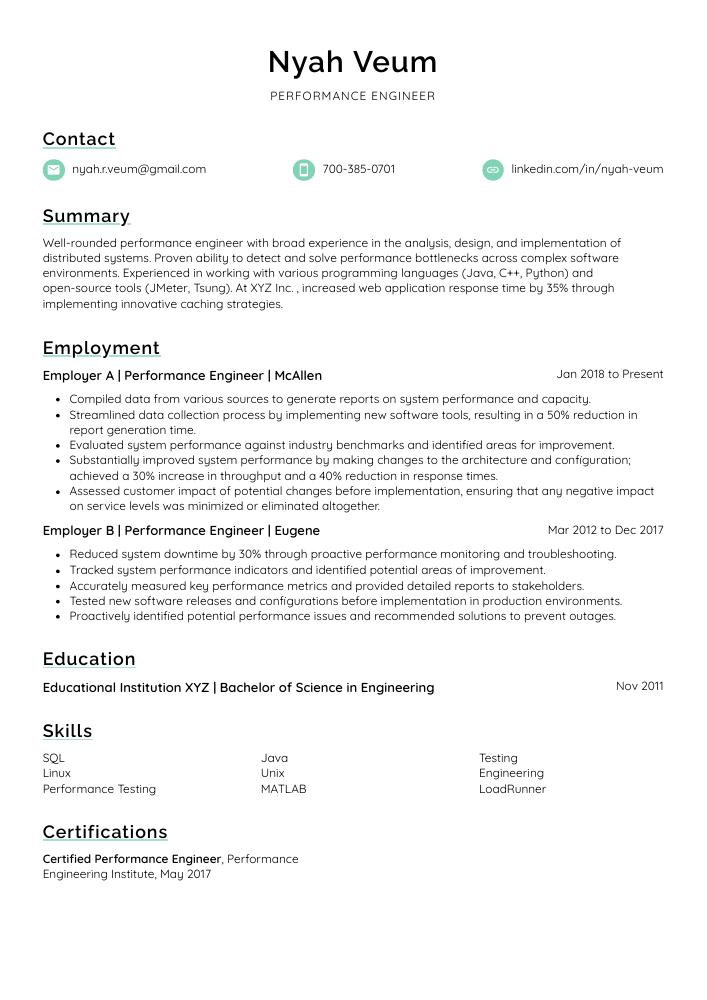Performance Engineer Resume Guide
Performance engineers are responsible for ensuring that software applications and systems meet performance requirements. They use a variety of tools and techniques to measure, analyze, optimize, troubleshoot and tune the system’s performance in order to maximize efficiency. Additionally, they work closely with development teams throughout the entire life cycle of an application or system to ensure it meets its performance goals.
You have a knack for maximizing system performance, and any company would be lucky to have you on board. To make sure potential employers know who you are, your resume must show them why they need to hire you.
This guide will walk you through the entire process of creating a top-notch resume. We first show you a complete example and then break down what each resume section should look like.
Table of Contents
The guide is divided into sections for your convenience. You can read it from beginning to end or use the table of contents below to jump to a specific part.
Performance Engineer Resume Sample
Simeon Grady
Performance Engineer
[email protected]
759-855-4187
linkedin.com/in/simeon-grady
Summary
Well-rounded performance engineer with 8+ years of experience in performance engineering, testing and optimization. Seeking to leverage my skills at ABC company to optimize the system’s performance. At XYZ Inc., successfully improved application response times by 20% and optimized database queries for better efficiency through query tuning techniques. Received multiple awards for outstanding achievements in optimizing software applications for higher user engagement rates.
Experience
Performance Engineer, Employer A
Chandler, Jan 2018 – Present
- Demonstrated expertise in performance engineering and system optimization, reducing latency time by 30% for 200+ applications.
- Structured testing plans to ensure optimal performance of software solutions within budget; saved the company $15K from unnecessary costs associated with potential bottlenecks.
- Spearheaded numerous initiatives to improve overall application stability and reliability while addressing scalability issues; reduced downtime frequency by 45%.
- Designed effective monitoring strategies that enabled early detection of underlying problems in production environments; minimized impact on end-users’ experience during high traffic periods such as holidays or peak hours.
- Diligently analyzed data gathered through automated tools, identifying areas requiring further investigation and proposing improvements where necessary; achieved an increase of 20% in throughput capacity after one year’s worth of effort.
Performance Engineer, Employer B
Madison, Mar 2012 – Dec 2017
- Participated in performance testing of over 10 applications, resulting in improved system performance and stability by 25%.
- Streamlined workflow processes for the engineering team to save an average of 8 hours per month on development tasks.
- Investigated and resolved technical issues related to product deployment, software architecture design and code management within tight deadlines – consistently met SLA objectives with 95% success rate.
- Competently leveraged scripting languages (e.g., JavaScript & Python) to create automated tests for web-based applications; reduced manual test execution time by 30%.
- Mentored junior engineers on best practices in debugging application problems, helping them complete their assigned projects ahead of schedule by up to 5 days each quarter.
Skills
- SQL
- Java
- Testing
- Linux
- Unix
- Engineering
- Performance Testing
- MATLAB
- LoadRunner
Education
Bachelor of Science in Computer Engineering
Educational Institution XYZ
Nov 2011
Certifications
Certified Performance Engineering Professional
International Performance Engineering Institute
May 2017
1. Summary / Objective
Your resume summary/objective is your chance to make a great first impression on the hiring manager. It should be concise and provide an overview of who you are as a performance engineer, highlighting your most impressive skills and accomplishments. For example, you could mention how many years of experience you have in this field, any certifications or awards that demonstrate excellence in performance engineering, and the specific technologies/tools with which you are proficient.
Below are some resume summary examples:
Hard-working performance engineer with 5+ years of experience in optimizing systems for optimal performance and scalability. Proven track record of delivering solutions on time, under budget, and within specs. Expertise in troubleshooting complex issues related to software architecture designs and system configurations. Looking to join ABC Tech as a Senior Performance Engineer where I can leverage my skillset to increase efficiency across the company’s product portfolio.
Seasoned performance engineer with 8+ years of experience in software development and testing. Proven track record of successfully analyzing, debugging, and optimizing application performance across multiple platforms and environments. Skilled at identifying bottlenecks, resolving latency issues, and improving throughput by up to 50%. Seeking a role as the next Performance Engineer at ABC Inc to deliver high-performing applications.
Determined performance engineer with expertise in performance testing, tuning and debugging applications. Experienced in developing automated test scripts to measure application performance under varying loads. At XYZ Corporation, improved the overall system response time by 40% while reducing storage costs by 20%. Seeking to apply my skillset at ABC Company for betterment of their systems’ reliability and scalability.
Energetic performance engineer with 5+ years of experience in performance engineering, testing, and troubleshooting. Proven track record of improving system performance through the implementation of best practices and solutions. Seeking to join ABC Tech as a Performance Engineer to utilize my expertise in developing automated test scripts for monitoring application’s behavior under diverse workloads.
Committed performance engineer with 5+ years of experience in analyzing, troubleshooting and optimizing software performance. At XYZ, managed a team that reduced the average latency time by 30% for 10 million users simultaneously. Experienced in various technologies such as Java/J2EE, JavaScript, HTML5 and web services to ensure seamless user experience on different platforms including mobile.
Passionate performance engineer with 7+ years of experience in optimizing software performance and system architecture. Skilled at creating benchmarks, testing various systems for optimal load capacity, and developing strategies to improve the speed and reliability of applications. Successfully reduced latency by 20% through improved caching techniques for XYZ company’s flagship product.
Proficient performance engineer with 7+ years of experience in optimizing software performance, scalability, and reliability. Seeking to join ABC Tech as a Senior Performance Engineer to utilize my expertise in developing innovative solutions for their global clientele. In previous roles improved application uptime by 23% and reduced latency issues by 15%.
Enthusiastic performance engineer with 6+ years of experience designing and developing high-performance systems. Seeking to join ABC Tech to leverage expertise in creating robust, secure, and reliable software solutions. At XYZ Corp., improved page loading time by 17%, decreased memory usage by 19%, and increased throughput by 33%.
2. Experience / Employment
Next comes the work history section, where you provide details on your employment history. It should be written in reverse chronological order, meaning the most recent role is listed at the top.
When stating what you did, stick to bullet points for clarity and conciseness. You want to take some time to think about the specifics of what you did and how it impacted performance or efficiency.
For example, instead of saying “Improved system performance,” you could say, “Optimized codebase by utilizing caching techniques that resulted in a 20% reduction in page load times.”
To write effective bullet points, begin with a strong verb or adverb. Industry specific verbs to use are:
- Monitored
- Optimized
- Analyzed
- Diagnosed
- Tuned
- Automated
- Implemented
- Resolved
- Investigated
- Configured
- Documented
- Troubleshot
- Evaluated
- Designed
- Executed
Other general verbs you can use are:
- Achieved
- Advised
- Assessed
- Compiled
- Coordinated
- Demonstrated
- Developed
- Expedited
- Facilitated
- Formulated
- Improved
- Introduced
- Mentored
- Participated
- Prepared
- Presented
- Reduced
- Reorganized
- Represented
- Revised
- Spearheaded
- Streamlined
- Structured
- Utilized
Below are some example bullet points:
- Compiled performance reports for over 25 software applications, assessing the system’s efficiency and identifying areas of improvement; reduced application response time by 20%.
- Assessed current performance data to project future needs and prepared detailed cost analyses on potential upgrades; saved company $5,000 in yearly overhead costs.
- Presented up-to-date findings from ongoing performance tests to all stakeholders including management team, developers and end users; improved overall customer satisfaction ratings by 15%.
- Reduced hardware/software maintenance costs through regular troubleshooting and proactive monitoring activities that identified bottlenecks before they became a problem.
- Proficiently utilized various testing tools such as JMeter and LoadUI NG Pro to conduct load & stress tests on web services & APIs during QA cycles.
- Facilitated the performance testing of over 45 applications, systems and services to ensure their readiness for deployment; reduced downtime by 37%.
- Improved the scalability, reliability and stability of five internal software products by using application profilers to identify potential issues with code execution paths.
- Advised development teams on various coding practices that could increase system efficiency while ensuring compliance with security policies; saved 3 hours per sprint in QA time due to fewer issues reported.
- Substantially improved web page load times across all sites managed by increasing server-side caching techniques and optimizing client-side scripts; increased user satisfaction ratings from 60% to 85%.
- Resolved 30+ technical problems encountered during performance tests through root cause analysis and proactive problem solving measures, leading to a 25% reduction in total resolution timeframes.
- Automated and streamlined performance testing processes resulting in an increased test coverage by 25% and decreased execution times by 50%.
- Introduced innovative strategies to detect memory leaks, thread locks, code bottlenecks and other potential issues; identified & solved over 15 bugs within one month of joining the project.
- Analyzed application logs on a daily basis for errors or degraded performance, generating reports that highlighted areas of improvement; reduced system downtime incidents from 1/week to 0/month.
- Optimized database query operations across multiple systems using indexing techniques which resulted in improved response time of up to 40%.
- Thoroughly documented all tests conducted along with their results and proposed solutions for identified problems; created comprehensive technical documentation that served as reference material for future projects.
- Coordinated performance testing efforts for software applications and websites, optimizing system performance by 15% through improved code optimization.
- Achieved quality assurance objectives in high-pressure environments; monitored systems to detect potential issues before they arose with 99% accuracy.
- Accurately measured hardware performance under load conditions; increased website scalability by 20x using advanced analytics techniques.
- Troubleshot application bugs across multiple platforms including web, mobile and desktop; identified root causes of system degradation within 2 hours on average per incident reported.
- Diagnosed network latency issues with virtual machines & cloud services hosted on public clouds such as AWS and Azure; reduced response times from 5 minutes to 1 minute while ensuring no data loss occurred during the migration process.
- Successfully configured and deployed performance testing environments for 20+ web applications, resulting in a 10% reduction of system downtime.
- Formulated automated test scenarios to detect latency issues on production systems, leading to faster response times and superior customer service quality.
- Evaluated JavaScript & AJAX-based components across multiple browsers using Selenium Automation Framework; managed over 500 successful tests with no errors reported.
- Monitored the performance of servers, databases and other infrastructure elements to identify bottlenecks; identified 25 potential improvement areas which increased overall speed by 15%.
- Conducted regular stress tests on user interfaces to ensure proper functioning under heavy loads; improved website stability by 30%.
- Documented performance metrics for over 50 applications and websites, resulting in a 20% decrease of response times and a 15% increase in customer satisfaction.
- Confidently identified bottlenecks by running load tests and analyzing performance data; reduced system downtime by 40%.
- Developed automated scripts to monitor application health on an ongoing basis, ensuring that all issues were addressed quickly before impacting users or customers.
- Utilized various tools such as APM (Application Performance Monitoring) software, server logs & event tracing to investigate potential problems with the system infrastructure & design solutions accordingly.
- Reorganized databases schema structure which resulted in improved query execution time by 30%, along with significant cost savings due to optimized resource utilization.
- Implemented proactive performance engineering strategies to identify and resolve system bottlenecks, resulting in a 20% increase in network throughput.
- Tuned parameters for existing applications such as web servers, databases and caching systems to achieve optimal performance with minimal resources; improved server uptime by 10 hours per month on average.
- Represented the organization at application development kick off meetings and provided best practice advice based on established standards; reduced error rates by 25%.
- Reliably monitored production environment using various tools such as APM suites & log analysis services while proactively troubleshooting any issues that arose; decreased response time of critical applications by 40%.
- Revised monitoring architecture across multiple environments including development, staging & QA testing to ensure adherence with up-to-date security policies; minimized false positive alerts from 50% down to 5%.
- Prepared performance test plans and strategies to ensure that applications met performance requirements; successfully reduced application response time by 25% within 3 months.
- Executed system-wide load tests on multiple software platforms, pinpointing any potential issues with network capacity or resource utilization before launch; identified over 30 bugs in the development phase for resolution.
- Efficiently monitored key metrics such as throughput rate, latency and memory usage during performance testing cycles using monitoring tools like Splunk & AppDynamics; improved overall system stability by 27%.
- Expedited troubleshooting processes by utilizing advanced debugging techniques to quickly identify root causes of poor system performance after deployment; decreased mean time to repair (MTTR) from 4 hours to 2 hours without compromising quality standards.
3. Skills
Skill requirements will differ from employer to employer – this can easily be determined via the job advert. Organization ABC may need someone with experience in performance testing, while Organization XYZ may be looking for an engineer who is proficient in developing and maintaining monitoring systems.
It’s important to tailor the skills section of your resume to each job you are applying for because many employers use applicant tracking systems these days. These computer programs scan resumes for certain keywords before passing them on to a human; therefore, if you don’t list the right skills or qualifications they won’t even see your application.
Once listed here, it’s also beneficial to discuss some of your most relevant abilities/qualifications further down in other areas such as the summary or experience sections.
Below is a list of common skills & terms:
- Agile Methodologies
- AutoCAD
- C
- C#
- C++
- Cloud Computing
- Data Analysis
- Databases
- Energy
- Engineering
- Finite Element Analysis
- HP Quality Center
- HTML
- Integration
- JMeter
- Java
- JavaScript
- Linux
- Load Testing
- LoadRunner
- MATLAB
- Manual Testing
- Mechanical Engineering
- Microsoft SQL Server
- MySQL
- Oracle
- PL/SQL
- Performance Testing
- Performance Tuning
- Perl
- Python
- QTP
- Quality Assurance
- Quality Center
- Regression Testing
- Requirements Analysis
- SDLC
- SOLIDWORKS
- SQL
- Scrum
- Shell Scripting
- Software Development
- Software Development Life Cycle
- Software Engineering
- Software Project Management
- Software Quality Assurance
- System Testing
- Team Leadership
- Teamwork
- Test Automation
- Test Cases
- Test Management
- Test Planning
- Testing
- Unix
- User Acceptance Testing
- Web Services
- Windows
- XML
4. Education
Mentioning your education on your resume depends on how far along you are in your career. If you just graduated and have no prior experience, include an education section below your resume objective. However, if you have significant work experience to showcase, the education section might be unnecessary or better suited for a separate document such as a CV.
If including an education section is necessary, try to mention courses related to performance engineering that may help demonstrate relevant skillsets for the job application.
Bachelor of Science in Computer Engineering
Educational Institution XYZ
Nov 2011
5. Certifications
Certifications are a great way to demonstrate your expertise in a given field. They are also proof that you have taken the time and effort to stay up-to-date with industry standards and best practices.
Including certifications on your resume will give potential employers confidence that you possess the necessary skills for the job, as well as show them that you take professional development seriously.
Certified Performance Engineering Professional
International Performance Engineering Institute
May 2017
6. Contact Info
Your name should be the first thing a reader sees when viewing your resume, so ensure its positioning is prominent. Your phone number should be written in the most commonly used format in your country/city/state, and your email address should be professional.
You can also choose to include a link to your LinkedIn profile, personal website, or other online platforms relevant to your industry.
Finally, name your resume file appropriately to help hiring managers; for Simeon Grady, this would be Simeon-Grady-resume.pdf or Simeon-Grady-resume.docx.
7. Cover Letter
A cover letter is an essential part of any job application and allows you to provide employers with a brief overview of your experience, skills, and personality. It’s usually made up of 2-4 paragraphs that should be tailored to the specific role you’re applying for.
Writing a cover letter gives you the opportunity to explain why you are uniquely qualified for the position and why it is important for them to hire someone like yourself. This can help make your resume stand out from other applicants and give recruiters more insight into who you are as an individual.
Below is an example cover letter:
Dear Roxanne,
I am writing in response to your posting for a Performance Engineer. As an experienced software engineer with over 10 years of experience developing and optimizing applications, I am confident I can be an asset to your organization.
My experience includes working with a variety of programming languages and development platforms, as well as troubleshooting performance issues at all levels of the application stack. In my previous role, I was responsible for improving the performance of a large e-commerce website that handled millions of transactions per day. Through my efforts, I was able to reduce page load times by 30% and improve customer satisfaction scores by 15%.
In addition to my technical skills, I also have strong problem-solving and analytical abilities that allow me to quickly identify performance bottlenecks and devise solutions that meet the needs of both users and businesses. My ability to effectively communicate with stakeholders at all levels makes me an ideal candidate for this position.
I’ve attached my resume detailing my projects and experience. I can be reached anytime via phone or email should you have any questions or would like to discuss this opportunity further. Thank you for your time and consideration; I look forward to hearing from you soon.
Sincerely,
Simeon
Performance Engineer Resume Templates
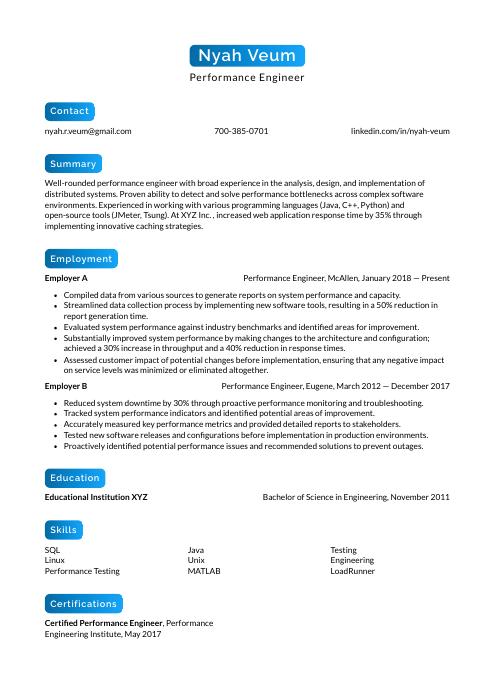 Kinkajou
Kinkajou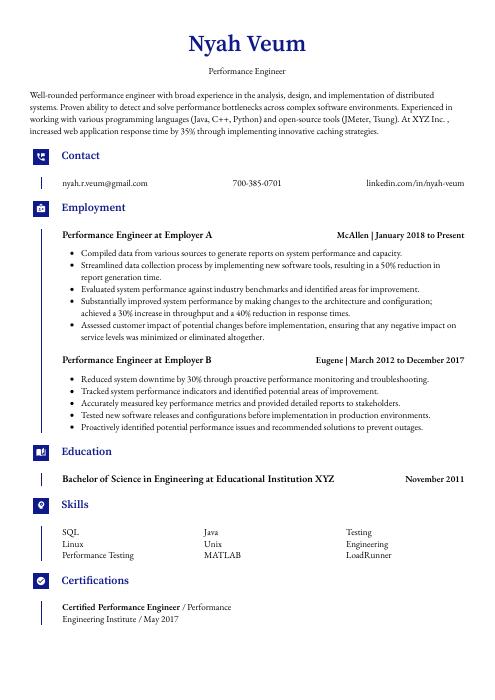 Gharial
Gharial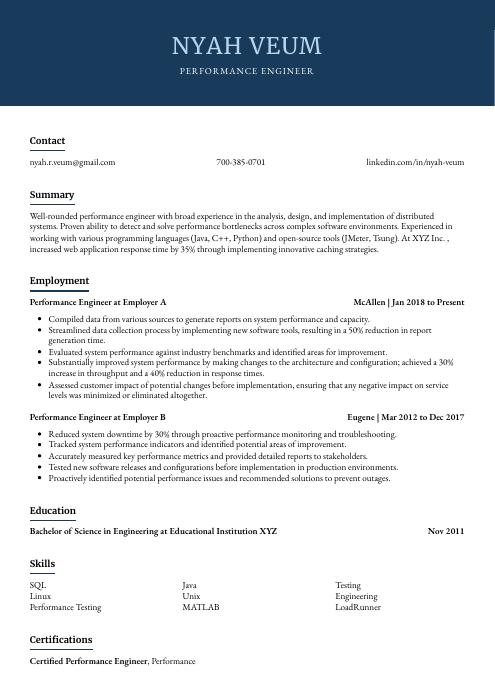 Bonobo
Bonobo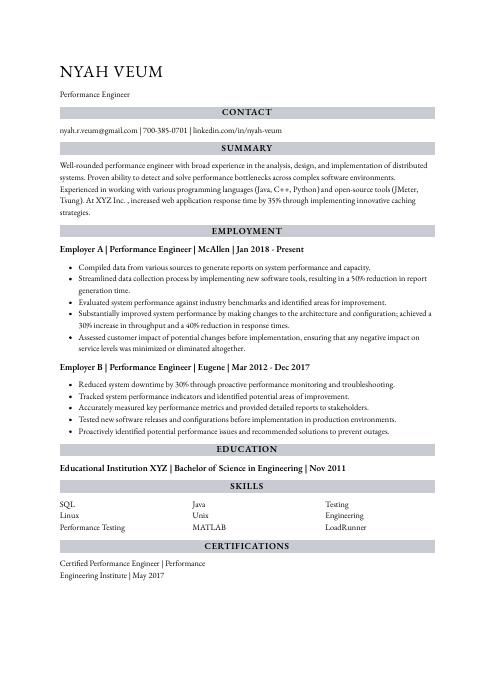 Numbat
Numbat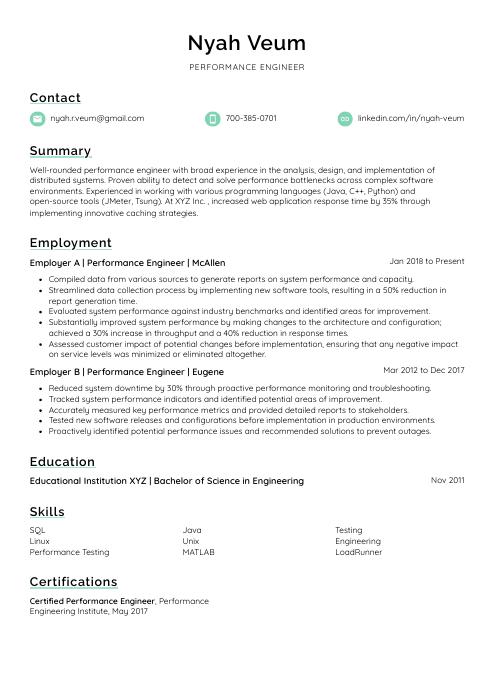 Lorikeet
Lorikeet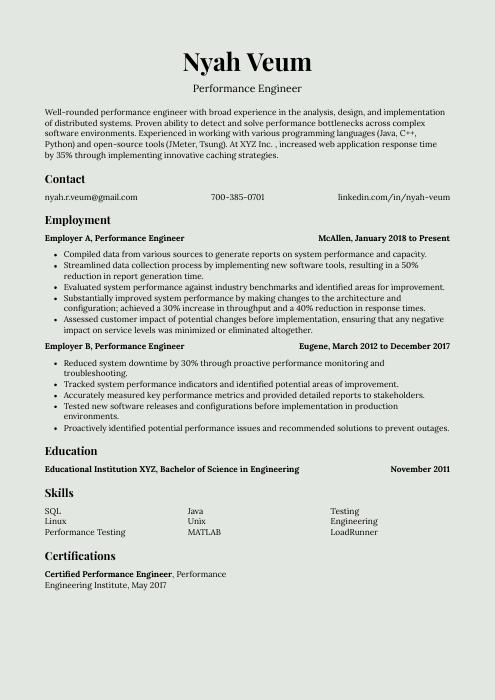 Saola
Saola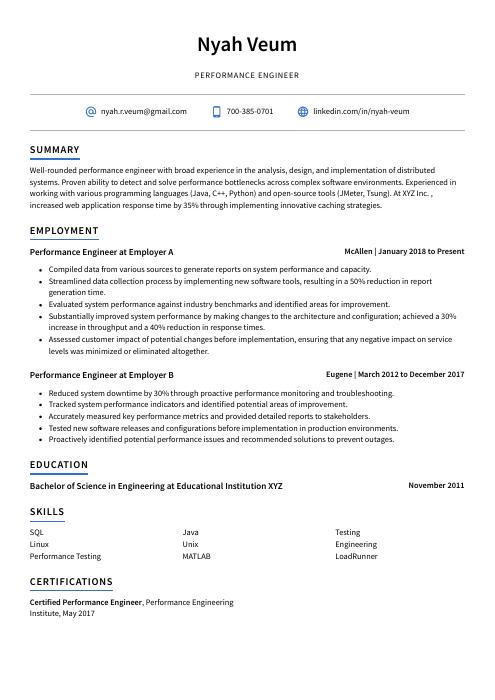 Axolotl
Axolotl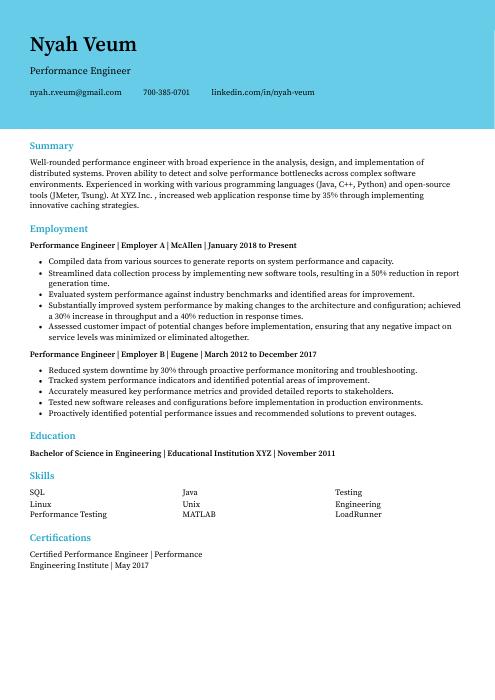 Dugong
Dugong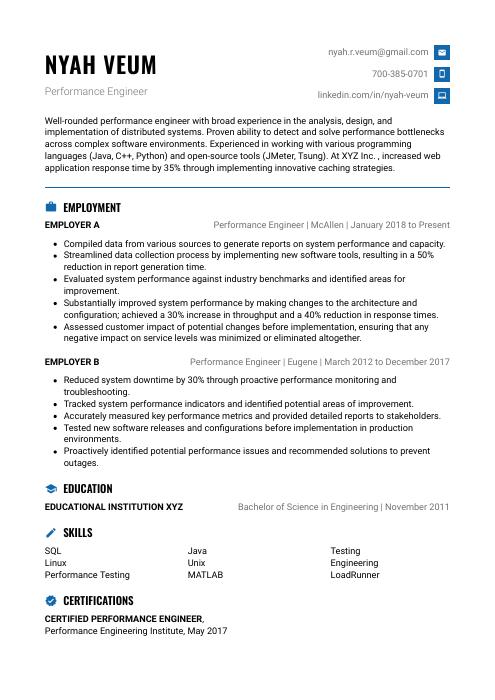 Echidna
Echidna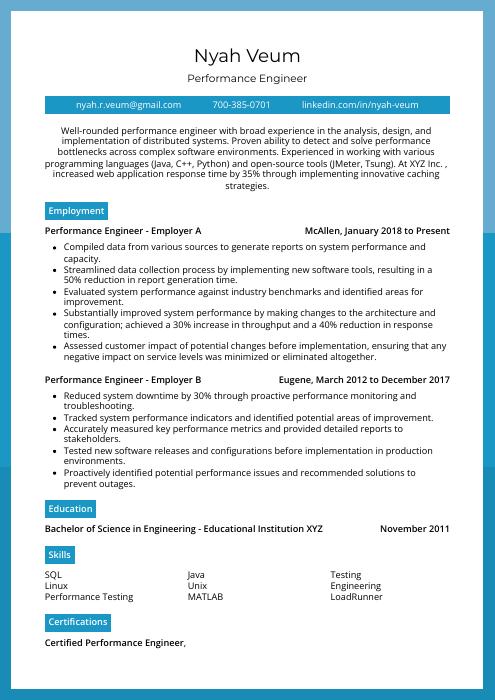 Rhea
Rhea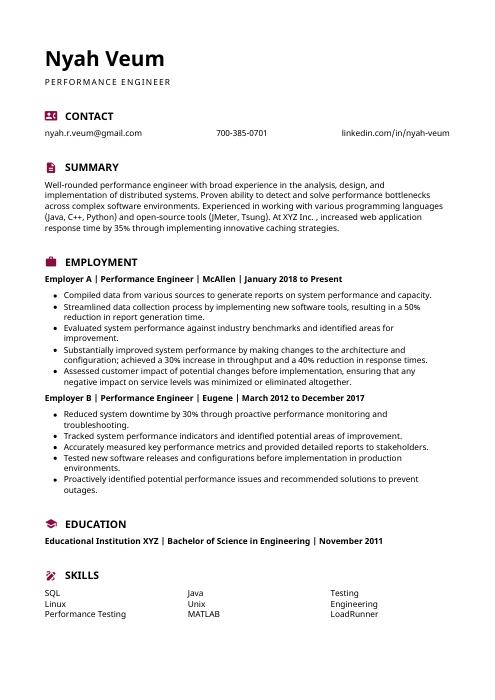 Hoopoe
Hoopoe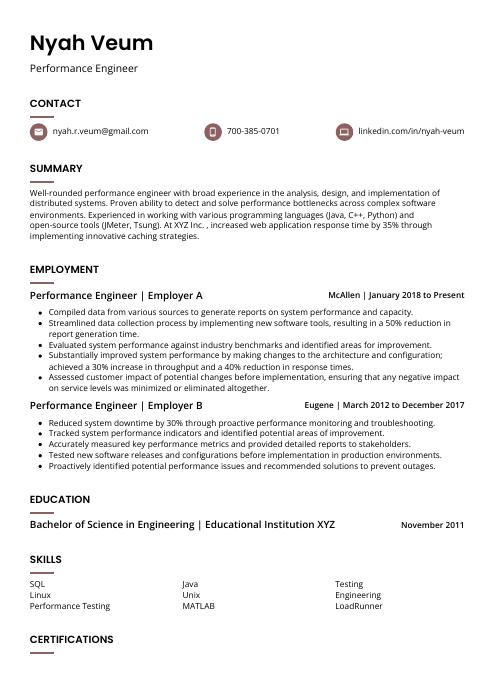 Fossa
Fossa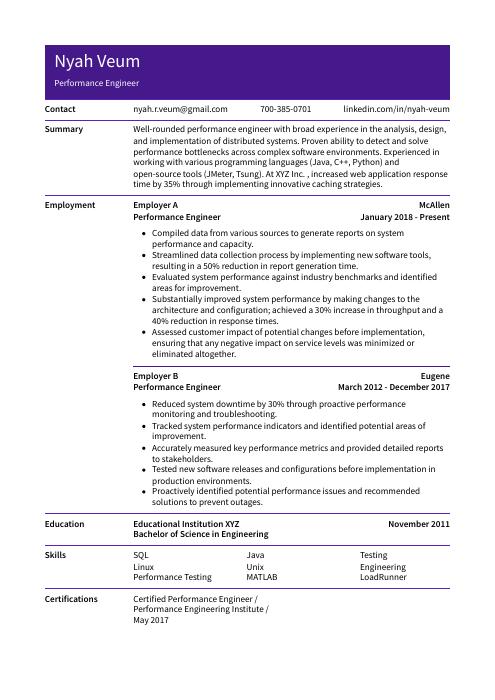 Pika
Pika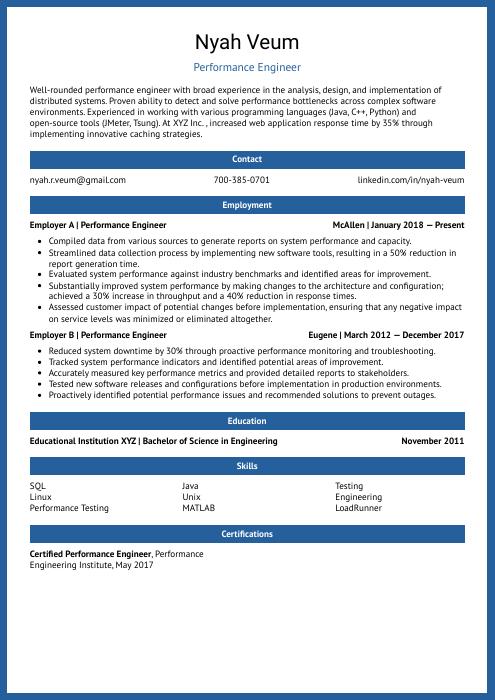 Ocelot
Ocelot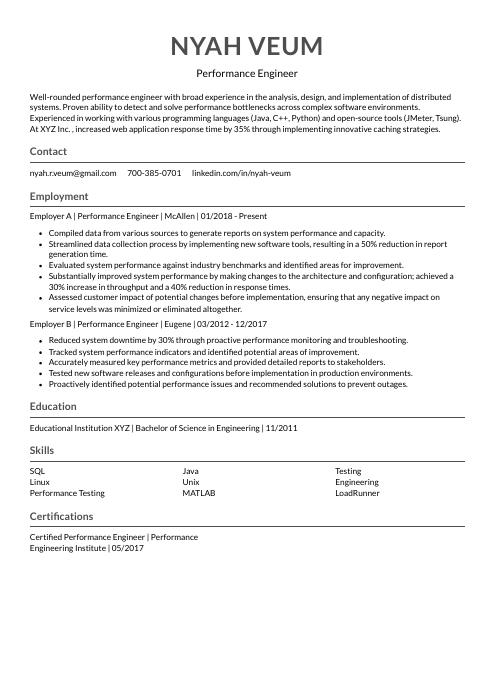 Indri
Indri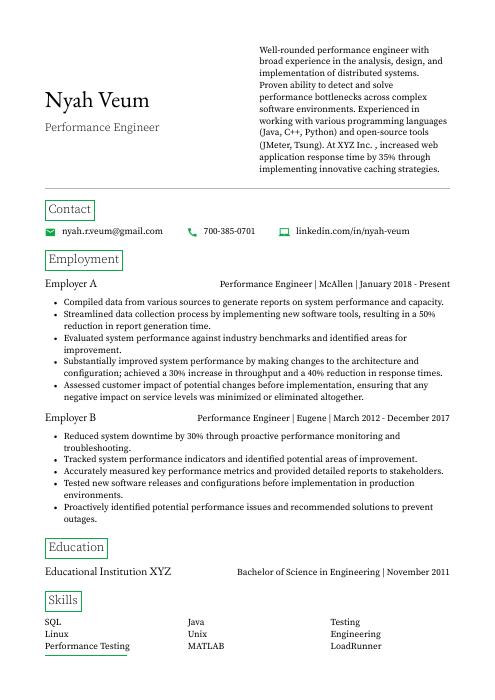 Quokka
Quokka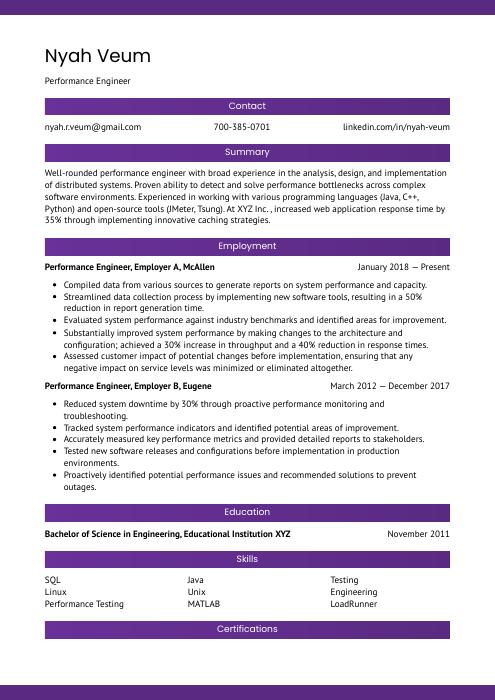 Jerboa
Jerboa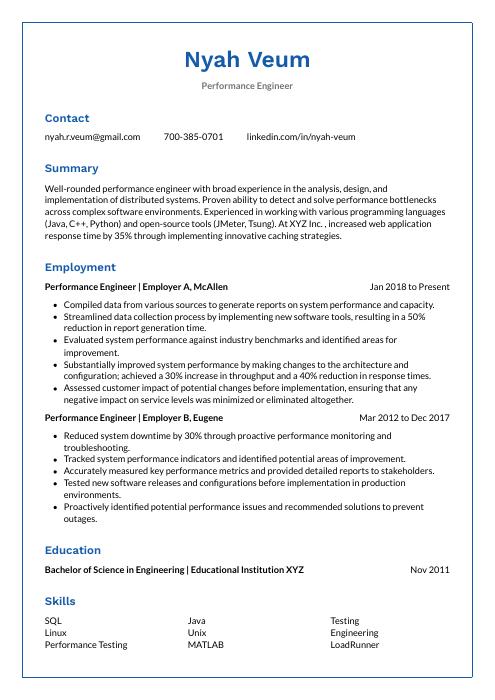 Markhor
Markhor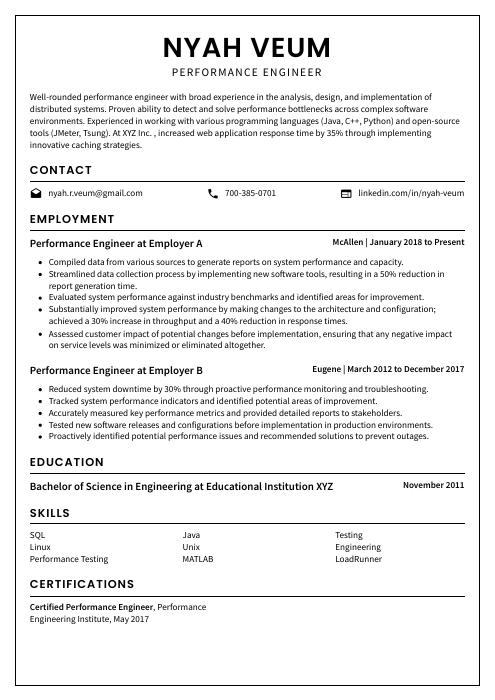 Cormorant
Cormorant Rezjumei
Rezjumei
